light Lexus IS250 2012 Using the air conditioning system and defogger / LEXUS 2012 IS250,IS350 (OM53A87U) Owner's Manual
[x] Cancel search | Manufacturer: LEXUS, Model Year: 2012, Model line: IS250, Model: Lexus IS250 2012Pages: 592, PDF Size: 6.2 MB
Page 83 of 592

83
1
1-4. Opening and closing the windows and moon roof
Before driving
Moon roof
Use the overhead switches to open, close, and tilt the moon roof up and
down.
■ Opening and closing
Open
*
The moon roof stops slightly
before the fully opened position.
Push the switch again to fully
open.
Close*
*: Lightly press either of the moonroof switches to stop the moon
roof partway.
■ Tilting up and down
Ti l t u p
*
Tilt down*
*: Lightly press either of the moonroof switches to stop the moon
roof partway.
�
: If equipped
Page 84 of 592

84
1-4. Opening and closing the windows and moon roof
■The moon roof can be operated when
The “ENGINE START STOP” switch is in IGNITION ON mode.
■Moon roof open warning buzzer
The buzzer sounds and a message is shown on the multi-information display in the
instrument panel when the “ENGINE START STOP” switch is turned OFF and the
driver's door is opened with the moon roof open.
■Door lock linked moon roof operation
The moon roof can be opened and closed using the mechanical key. ( P. 505)
■Operating the moon roof after turning the “ENGINE START STOP” switch OFF
The moon roof can be operated for ap proximately 45 seconds even after the
“ENGINE START STOP” switch is switched to ACCESSORY mode or turned
OFF. It cannot, however, be operated once either front door is opened.
■Jam protection function
If an object is detected between the moon roof and the frame while closing or tilting
down, travel is stopped and the moon roof opens slightly.
■To reduce moon roof wind noise
When the moon roof is opened automatically, it will stop slightly before the fully
open position. Driving with the moon roof in this position can help reduce wind
noise.
■Sunshade
The sunshade can be opened and closed manually. However, the sunshade will
open automatically when the moon roof is opened.
Page 85 of 592

85
1-4. Opening and closing the windows and moon roof
1
Before driving
■If the moon roof closes but then re-opens slightlyStop the vehicle.
Press and hold the “CLOSE” switch until the moon roof completely
closes.
During the operation, the moon roof will move in the manner outlined
below. If the switch is released during the operation, the operation will
have to be performed again from the beginning.
The moon roof will close, open and then pause for approximately 10 sec-
onds. Then it will close, tilt up and pause for approximately 1 second, after
which it will tilt down and open and then close.
If the moon roof does not fully close even after performing the above procedure
correctly, have the vehicle inspected by your Lexus dealer.
■If the moon roof tilts down but then tilts back up Stop the vehicle.
Press and hold the “TILT” switch until the moon roof moves into the tilt up
position and stops.
Release the “TILT” switch once and then press and hold the “TILT” switch
until the moon roof completely closes.
After moving to the tilt up position, the moon roof will move in the follow-
ing manner. If the switch is released during the operation, the operation
will have to be performe d again from the beginning.
The moon roof will pause for approxim ately 10 seconds while in the tilt up
position and then make some fine adjustments. Following this, it will pause
for approximately 1 second, tilt down, open and then close.
If the moon roof does not fully close even after performing the above procedure
correctly, have the vehicle inspected by your Lexus dealer.
■Customization that can be configured at Lexus dealer
Settings (e.g. linked door lock operation) can be changed.
(Customizable features P. 5 5 3 )
STEP1
STEP2
STEP1
STEP2
STEP3
Page 88 of 592
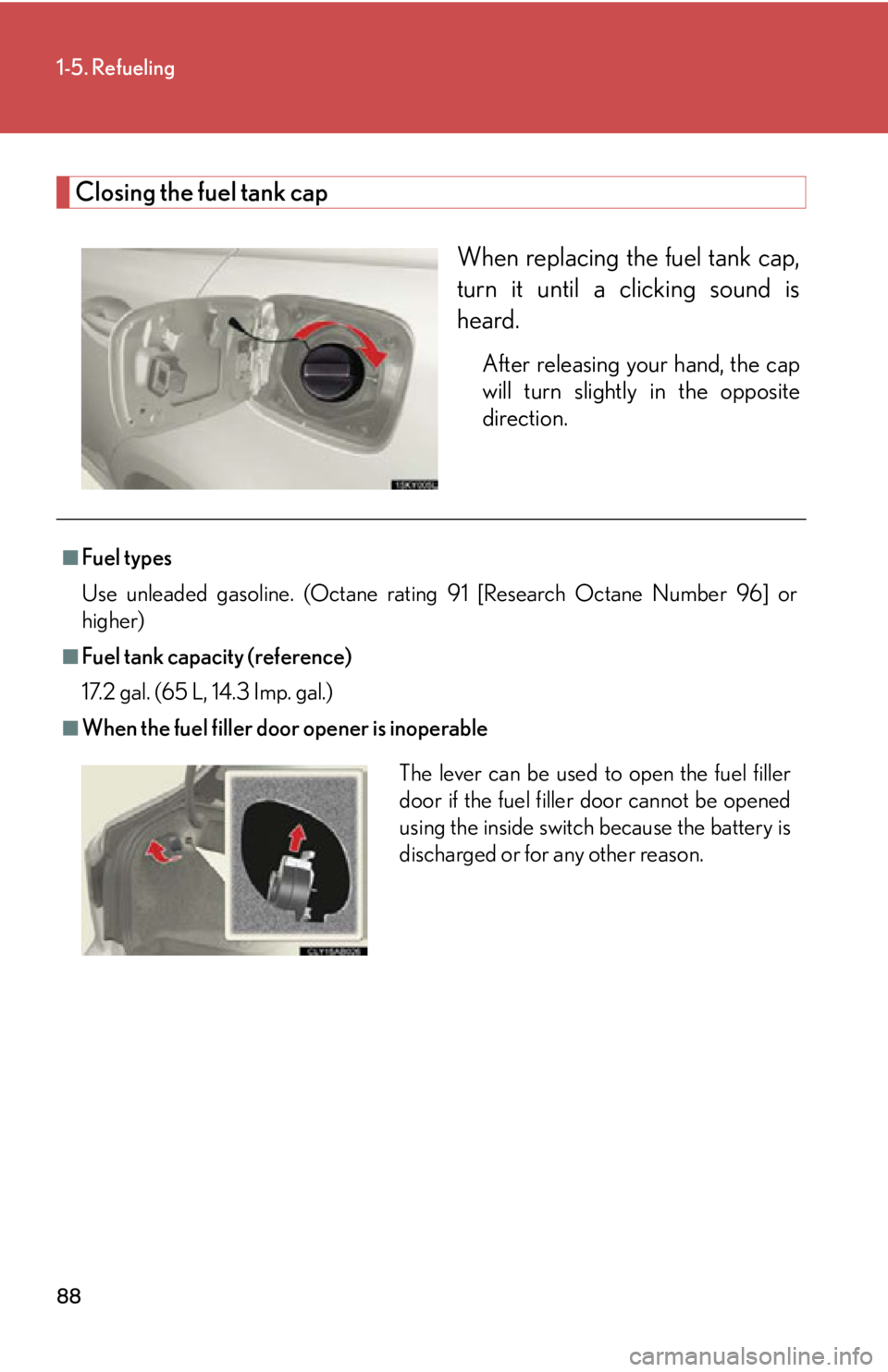
88
1-5. Refueling
Closing the fuel tank capWhen replacing the fuel tank cap,
turn it until a clicking sound is
heard.
After releasing your hand, the cap
will turn slightly in the opposite
direction.
■Fuel types
Use unleaded gasoline. (Octane rating 91 [Research Octane Number 96] or
higher)
■Fuel tank capacity (reference)
17.2 gal. (65 L, 14.3 Imp. gal.)
■When the fuel filler door opener is inoperable
The lever can be used to open the fuel filler
door if the fuel filler door cannot be opened
using the inside switch because the battery is
discharged or for any other reason.
Page 90 of 592
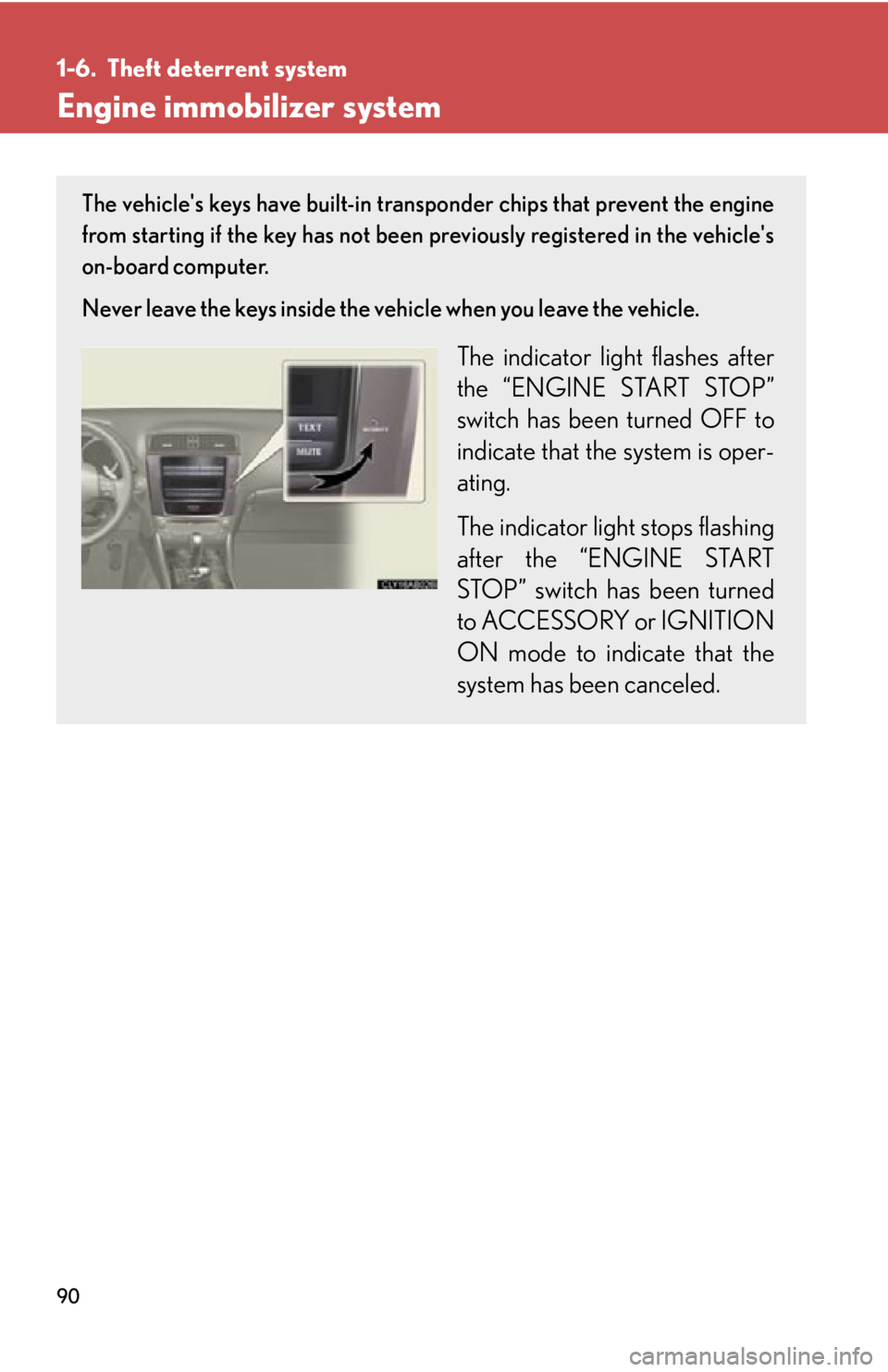
90
1-6. Theft deterrent system
Engine immobilizer system
The vehicle's keys have built-in transponder chips that prevent the engine
from starting if the key has not been previously registered in the vehicle's
on-board computer.
Never leave the keys inside the vehicle when you leave the vehicle.
The indicator light flashes after
the “ENGINE START STOP”
switch has been turned OFF to
indicate that the system is oper-
ating.
The indicator light stops flashing
after the “ENGINE START
STOP” switch has been turned
to ACCESSORY or IGNITION
ON mode to indicate that the
system has been canceled.
Page 92 of 592
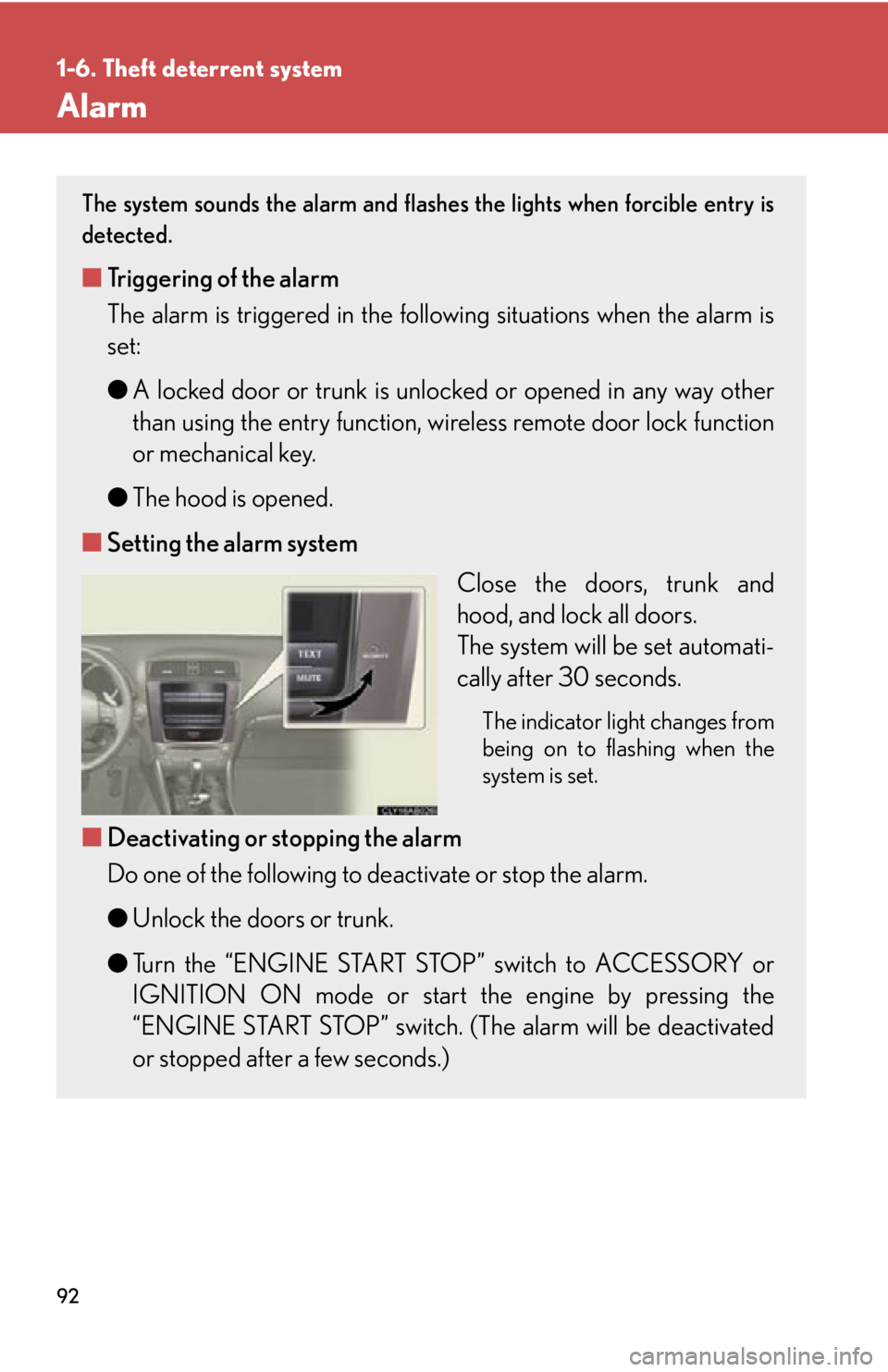
92
1-6. Theft deterrent system
Alarm
The system sounds the alarm and flashes the lights when forcible entry is
detected.
■ Triggering of the alarm
The alarm is triggered in the following situations when the alarm is
set:
●A locked door or trunk is unlocked or opened in any way other
than using the entry function, wi reless remote door lock function
or mechanical key.
● The hood is opened.
■ Setting the alarm system
Close the doors, trunk and
hood, and lock all doors.
The system will be set automati-
cally after 30 seconds.
The indicator light changes from
being on to flashing when the
system is set.
■Deactivating or stopping the alarm
Do one of the following to deactivate or stop the alarm.
●Unlock the doors or trunk.
● Turn the “ENGINE START STOP” switch to ACCESSORY or
IGNITION ON mode or start the engine by pressing the
“ENGINE START STOP” switch. (The alarm will be deactivated
or stopped after a few seconds.)
Page 99 of 592
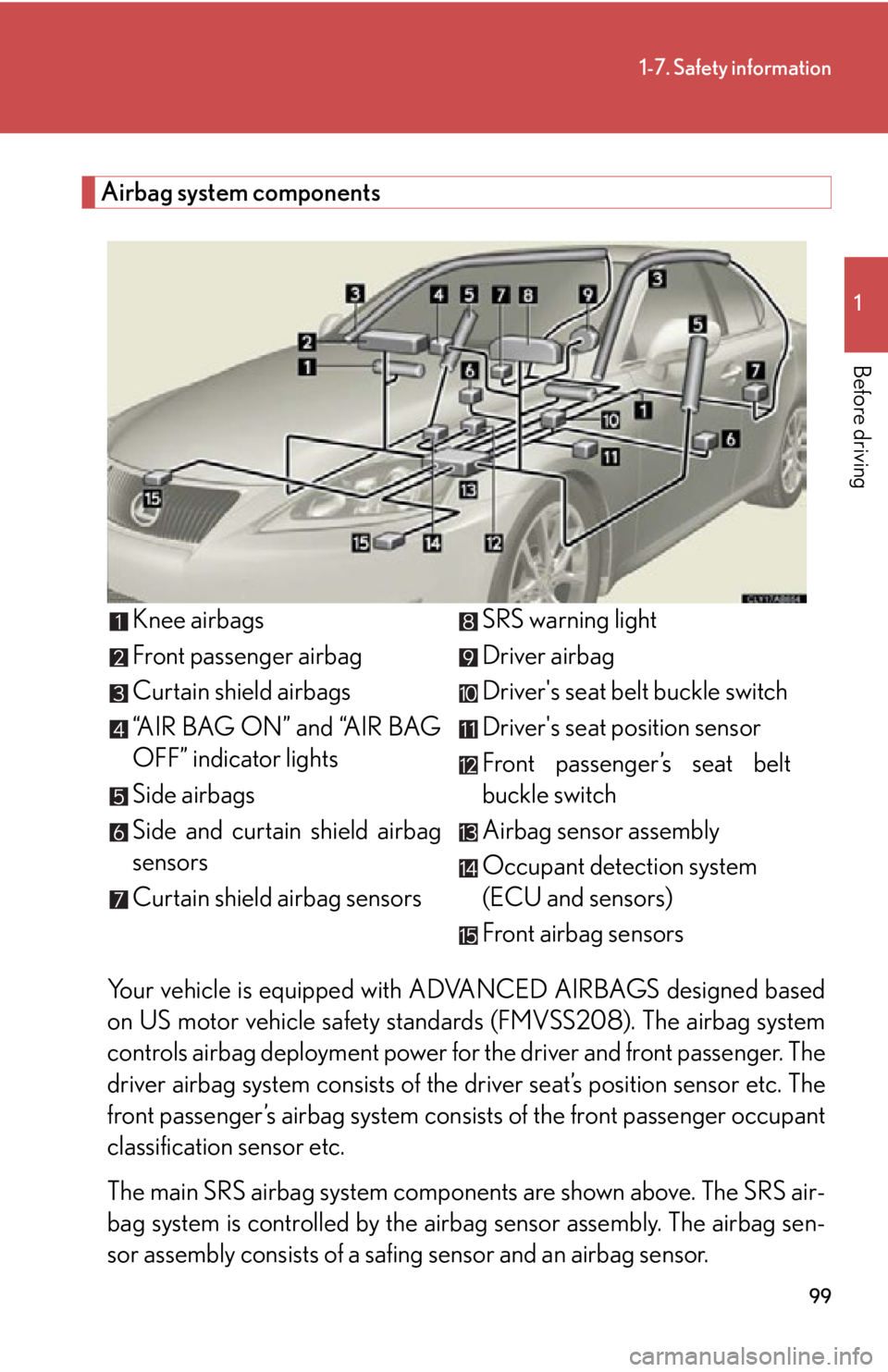
99
1-7. Safety information
1
Before driving
Airbag system componentsYour vehicle is equipped with AD VANCED AIRBAGS designed based
on US motor vehicle sa fety standards (FMVSS208). The airbag system
controls airbag deployment power for the driver and front passenger. The
driver airbag system consists of the driver seat’s position sensor etc. The
front passenger’s airbag system con sists of the front passenger occupant
classification sensor etc.
The main SRS airbag system componen ts are shown above. The SRS air-
bag system is controlled by the airb ag sensor assembly. The airbag sen-
sor assembly consists of a safing sensor and an airbag sensor.
Knee airbags
Front passenger airbag
Curtain shield airbags
“AIR BAG ON” and “AIR BAG
OFF” indicator lights
Side airbags
Side and curtain shield airbag
sensors
Curtain shield airbag sensors
SRS warning light
Driver airbag
Driver's seat belt buckle switch
Driver's seat position sensor
Front passenger’s seat belt
buckle switch
Airbag sensor assembly
Occupant detection system
(ECU and sensors)
Front airbag sensors
Page 100 of 592

100
1-7. Safety information
In certain types of severe frontal or side impacts, the SRS airbag system
triggers the airbag inflators. A chemica l reaction in the inflators quickly
fills the airbags with non-toxic gas to he lp restrain the motion of the occu-
pants.
■SRS warning light
This warning light system monitors the airb ag sensor assembly, front airbag sensors,
side and curtain shield airbag sensor assemblies, curtain shield airbag sensor
assemblies, driver's seat position sensor, driver's seat belt buckle switch, seat belt
pretensioner assemblies, inflators, inte rconnecting wiring and power sources.
( P. 4 7 2 )
■If the SRS airbags deploy (inflate)
●Bruising and slight abrasion s may result from contact with a deploying (inflating)
SRS airbag.
●A loud noise and white powder will be emitted.
●Parts of the airbag module (steering wheel , airbag cover and inflator) as well as
the front seats, and parts of the front pill ar, rear pillar and roof side rail, may be
hot for several minutes. The airbag itself may also be hot.
●The windshield may crack.
●For Safety Connect subscribers, if the SRS airbags deploy or in the event of a
severe rear-end collision, the system is designed to send an emergency call to
the response center, notifying them of the vehicle’s location (without needing to
push the “SOS” button) and an agent will attempt to speak with the occupants
to ascertain the level of emergency and assistance required. If the occupants
are unable to communicate, the agent automatically treats the call as an emer-
gency and helps to dispatch the necessary emergency services. ( P. 3 7 0 )
Page 104 of 592
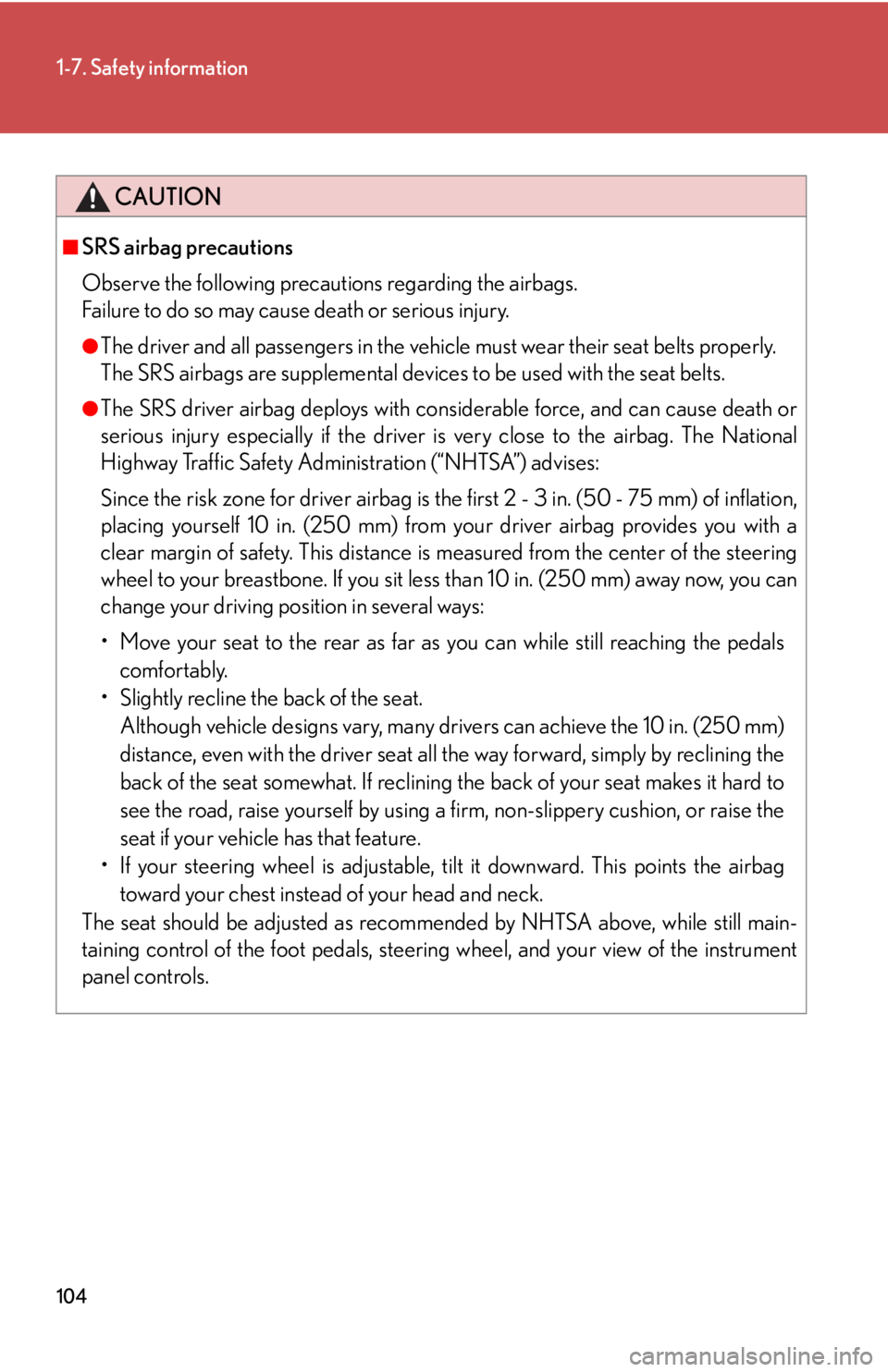
104
1-7. Safety information
CAUTION
■SRS airbag precautions
Observe the following precautions regarding the airbags.
Failure to do so may cause death or serious injury.
●The driver and all passengers in the vehicle must wear their seat belts properly.
The SRS airbags are supplemental devices to be used with the seat belts.
●The SRS driver airbag deploys with considerable force, and can cause death or
serious injury especially if the driver is very close to the airbag. The National
Highway Traffic Safety Administration (“NHTSA”) advises:
Since the risk zone for driver airbag is th e first 2 - 3 in. (50 - 75 mm) of inflation,
placing yourself 10 in. (250 mm) from your driver airbag provides you with a
clear margin of safety. This distance is measured from the center of the steering
wheel to your breastbone. If you sit less than 10 in. (250 mm) away now, you can
change your driving position in several ways:
• Move your seat to the rear as far as you can while still reaching the pedals
comfortably.
• Slightly recline the back of the seat. Although vehicle designs vary, many dr ivers can achieve the 10 in. (250 mm)
distance, even with the driver seat all the way forward, simply by reclining the
back of the seat somewhat. If reclining the back of your seat makes it hard to
see the road, raise yourself by using a firm, non-slippery cushion, or raise the
seat if your vehicle has that feature.
• If your steering wheel is adjustable, ti lt it downward. This points the airbag
toward your chest instead of your head and neck.
The seat should be adjusted as recommended by NHTSA above, while still main-
taining control of the foot pedals, steering wheel, and your view of the instrument
panel controls.
Page 109 of 592

109
1
1-7. Safety information
Before driving
Front passenger occupant classification system
Your vehicle is equipped with a front passenger occupant classification sys-
tem. This system detects the conditions of the front passenger seat and
activates or deactivates the devices for the front passenger.
SRS warning light
“AIR BAG OFF” indicator light
“AIR BAG ON” indicator light
Front passenger’s seat belt reminder light